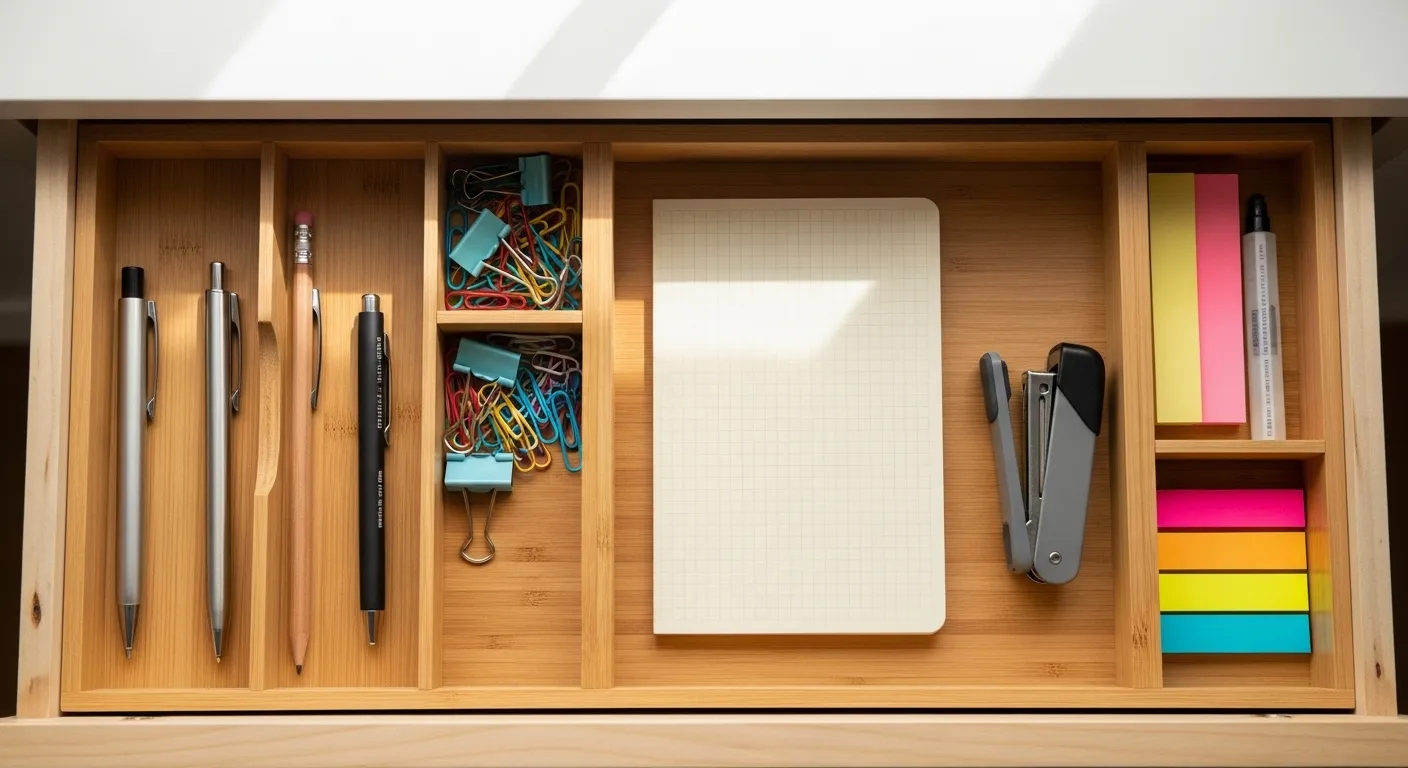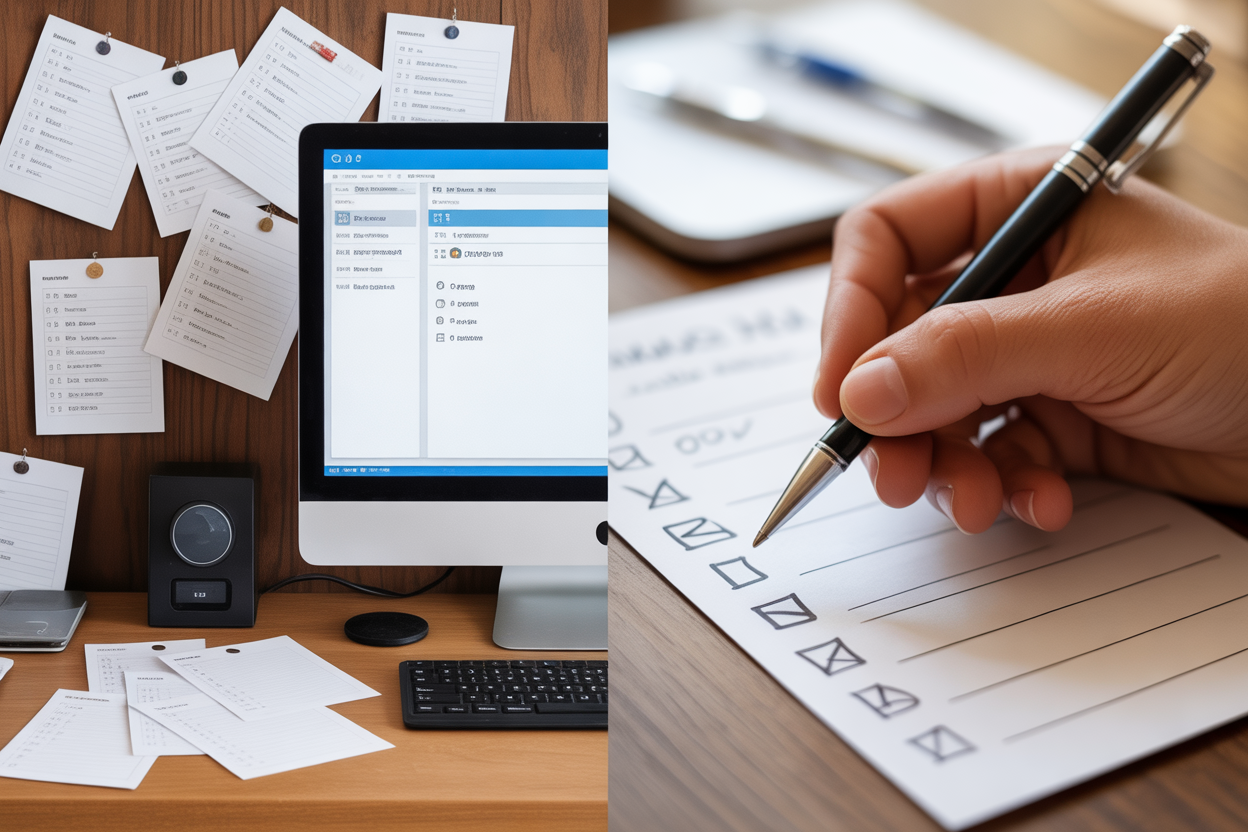
📚 Table of Contents
- 1. They Never Start Without a Plan (Even a Tiny One)
- 2. They Never Let Their Phone Run Their Day
- 3. They Never Work in a Cluttered Environment
- 4. They Never Treat All Tasks Equally
- 5. They Never Guess Where Their Time Goes
- Putting It All Together: Compounding Habits and Real-World Examples
- Frequently Asked Questions About Productivity Habits
- Is it about the tools or the habits?
- How do I handle the “switching cost” of starting a new habit?
- What if a productivity hack doesn’t work for me?
- How do I stay consistent when I have an off day?
- Can you over-optimize your life?
- Your First Steps to Sustainable Productivity
Productivity isn’t about heroic, white-knuckle effort. It isn’t about working 80-hour weeks, fueled by caffeine and a fear of falling behind. That’s a recipe for burnout, not sustainable success. The most consistently productive people don’t have more willpower or more hours in the day. They have better systems.
They understand a fundamental truth: motivation is fleeting, but habits are forever. They design their days around small, repeatable actions that eliminate friction and make focus the path of least resistance. They don’t fight against distraction; they engineer their environment so distraction rarely has a chance to take root.
What sets them apart often isn’t what they do, but what they consciously choose not to do. They avoid common traps that drain energy, splinter attention, and create a constant state of reactive busyness. They trade the illusion of being busy for the quiet confidence of being effective.
In this guide, we’ll break down five things truly productive people never do. More importantly, we’ll reveal the simple, powerful systems they use instead. These aren’t complex life overhauls. They are small, practical shifts you can implement today to reclaim your focus, get more done, and end your day feeling accomplished, not exhausted.
1. They Never Start Without a Plan (Even a Tiny One)
How does your workday begin? For many, it’s a jolt of digital chaos. You grab your phone, open your email, and immediately, your priorities are hijacked. Dozens of other people’s agendas—urgent requests, meeting invites, notifications—flood your brain. You start your day on defense, reacting to inbound traffic instead of steering your own ship.
Productive people refuse to start this way. They know that the first 30 minutes of the day set the trajectory for the next eight hours. Ceding that control to an inbox is like letting your boat drift out of the harbor without a hand on the rudder. You’ll be busy, but you won’t be heading toward your destination.
What They Do Instead: Define the Day with the 1-3-5 Rule.
Before the digital noise begins, they create a simple, powerful roadmap for the day. One of the most effective methods is the 1-3-5 Rule. It’s a method of prioritizing tasks that acknowledges you can’t do everything, but you can accomplish what truly matters.
Here’s how it works: Each day, decide you will accomplish:
One big thing.
Three medium things.
Five small things.
Your one big thing is your most significant task, the one that moves a major project forward. If you only did this one thing all day, you would still feel productive. This is your primary focus.
Your three medium things are important but less demanding tasks. Think of preparing for a key meeting, following up on a client proposal, or outlining a report. They require effort but not the same deep focus as your big task.
Your five small things are the quick administrative tasks that keep things moving: responding to a specific email, scheduling an appointment, or paying a bill. These are the things that can be done in 15 minutes or less.
The magic of the 1-3-5 rule is its built-in realism. It forces you to be intentional. You can’t list ten major projects. You must choose. This act of choosing, done in the quiet of the morning before the world rushes in, is your first and most important productivity win of the day. Write it down on a sticky note or a plain text file. That’s your charter for the day, a constant reminder of what success looks like.

2. They Never Let Their Phone Run Their Day
The smartphone is the greatest productivity tool and the greatest productivity destroyer ever invented. Its default state is engineered to addict you. Badges, banners, and endless notification sounds create a constant sense of manufactured urgency, pulling your attention away from deep, meaningful work.
Most people treat their phone like a demanding toddler, giving it attention whenever it screams. They leave notifications on for every app, place their most distracting apps on the home screen, and check it dozens, if not hundreds, of times per day. This isn’t just a bad habit; it’s a cognitive disaster. Every time you’re pulled away from a task, it takes significant time and mental energy to re-engage. This is known as “context switching,” and it obliterates focus.
Productive people understand this. They don’t rely on willpower to ignore their phone; they architect their relationship with it to serve their goals, not the goals of app developers.
What They Do Instead: Engineer a Zero-Friction, One-Screen Phone.
They turn their phone from a slot machine into a simple tool. The goal is to make intentional use easy and mindless scrolling difficult. One of the most powerful successful habits you can adopt is the one-screen phone setup.
Here’s the exact process:
First, turn off almost all notifications. Go into your phone’s settings and disable notifications for every app except for essentials like phone calls, text messages from actual people (not automated systems), and your calendar. No social media, no news alerts, no email banners. You will check these apps on your own schedule, not when they demand it.
Second, curate your home screen. Drag every single app off your home screen until it is blank. Then, move only your essential, tool-based apps back. This usually includes the phone, messages, camera, and maybe a notes app or a maps app. Put them in the dock at the bottom.
Third, hide the distractions. Move all your other apps—especially social media, news, and games—onto a second or third screen. Do not put them in folders. The point is to make them slightly inconvenient to access. To open Instagram, you’ll have to consciously swipe over and find it, a small moment of friction that gives you a chance to ask, “Do I really want to do this?”
For an even more advanced setup, remove them from your home screens entirely and only access them by using your phone’s search function. You have to type the name of the app to open it. This simple act transforms your phone from a passive content consumption device into an active, intention-driven tool.

3. They Never Work in a Cluttered Environment
Think about the feeling of sitting down at a desk covered in old coffee mugs, scattered papers, tangled cords, and random stacks of books. Now, picture sitting down at a clear, open desk with only your laptop, a notepad, and a pen. Which environment makes you feel more focused, calm, and ready to work?
Clutter isn’t just a physical problem; it’s a cognitive one. A messy environment bombards our minds with excessive stimuli, causing our senses to work overtime. This constant, low-level distraction competes for our attention and drains our mental energy before we even start the task at hand. It creates friction. Every item is a tiny, unresolved decision, and the sum of that visual noise makes deep work feel nearly impossible.
People who struggle with productivity often work in chaos, telling themselves they don’t have time to clean up. Productive people know they don’t have time not to.
What They Do Instead: Implement a 10-Minute Desk Reset.
They don’t wait for the clutter to become overwhelming. They build a tiny, non-negotiable habit into their routine: the 10-minute desk reset. This is one of the most powerful productivity habits because it bookends the day with intention.
Here’s the ritual: at the very end of your workday, before you shut down your computer, set a timer for 10 minutes. In that time, your only goal is to reset your workspace to a “ready to launch” state.
This includes:
Putting everything away. Papers go into files, books go back on the shelf, pens go into a holder.
Clearing surfaces. Take any dishes to the kitchen and wipe down your desk surface.
Managing cables. Tidy up any charging cables or accessories.
Preparing for tomorrow. Look at your calendar or your 1-3-5 list for the next day. Pull out the one notebook or file you’ll need for your first, most important task. Place it in the center of your desk.
This simple act does two things. First, it creates a powerful psychological boundary. The “reset” signals to your brain that the workday is officially over, helping you disconnect and rest more effectively. Second, it gives your future self an incredible gift. When you walk into your office the next morning, you aren’t met with the stressful residue of yesterday. You’re greeted by a calm, inviting space, with the tools for your most important work already waiting for you. The friction to getting started is zero.

4. They Never Treat All Tasks Equally
The “to-do list” can be a trap. A typical list is a flat, democratic collection of tasks, where “Email Bob about the Q3 report” has the same visual weight as “Draft the entire marketing strategy.” This leads to a common productivity pitfall: prioritizing the easy and urgent over the difficult and important.
We get a small dopamine hit from checking off a task, so our brains naturally gravitate toward clearing out the small stuff first. We spend hours answering emails, attending low-impact meetings, and handling minor requests. We feel incredibly busy, but at the end of the day, we look back and realize we made zero progress on the big projects that actually move the needle. We were active, but not effective.
Productive people resist the allure of being busy. They understand that not all work is created equal and rigorously protect their time and energy for high-impact activities.
What They Do Instead: They Batch and Timebox Their Work.
Instead of randomly tackling tasks, they use two powerful techniques to bring structure and focus to their day: batching and timeboxing.
Batching is the practice of grouping similar tasks together and doing them all in one dedicated session. The classic example is email. Instead of checking email every 10 minutes, you process it in two or three scheduled “batches” per day—say, at 11:00 AM and 4:00 PM. This same logic applies to making phone calls, running errands, or doing administrative paperwork. Batching is effective because it minimizes context switching. Your brain can stay in “email mode” or “phone call mode” without the high mental cost of constantly changing gears.
Timeboxing is the art of assigning a specific job to a specific block of time, in advance. You don’t just say, “I’ll work on the presentation today.” You go to your calendar and block out 1:00 PM to 2:30 PM and label it: “Work on Marketing Presentation Slides.” This block of time now has a single, defined purpose. It’s an appointment with your most important work.
When you combine these, you create an incredibly focused workflow. For example, a manager might timebox a 45-minute block from 9:15 AM to 10:00 AM for “Batch 1: Respond to High-Priority Team Emails.” During that time, that is their entire world. They don’t check social media or work on another report. This transforms your calendar from a record of meetings into a strategic plan for how you will invest your most valuable resource: your attention.

5. They Never Guess Where Their Time Goes
If I asked you how much time you spent last week in meetings, checking email, or scrolling social media, you would probably give me a confident answer. And you would probably be wrong. Research consistently shows that humans are terrible at estimating how they spend their time. We overestimate time spent on productive tasks and dramatically underestimate time lost to distractions and low-value activities.
Operating on guesswork is like trying to manage a company’s budget without looking at the financial statements. You’re making critical decisions based on feelings and flawed perceptions, not on data. You might feel like you “don’t have time” for a new project or a personal goal, when in reality, your time is being silently consumed by a dozen invisible leaks.
Productive people don’t guess. They know. They don’t trust their feelings about their time; they track the data, because what gets measured gets managed.
What They Do Instead: They Conduct a Simple Time Audit.
They periodically perform a time audit. This isn’t a permanent, lifelong activity. It’s a short-term diagnostic tool used to gain clarity. For three to five days, you simply track what you’re doing in 15 or 30-minute increments. That’s it. There’s no immediate goal to change anything, only to observe and record.
You can do this with a simple notebook, a spreadsheet, or a tracking app. The log might look something like this:
8:30 – 8:45 AM: Checked and replied to urgent emails.
8:45 – 9:00 AM: Scrolled news headlines and social media.
9:00 – 9:15 AM: Got coffee, chatted with a colleague.
9:15 – 10:00 AM: Attended the daily stand-up meeting.
10:00 – 10:30 AM: Tried to start the project proposal, but was distracted by notifications.
The goal is ruthless honesty without judgment. You are a scientist observing your own behavior. At the end of the audit period, you review the data. The results are often shocking. You might discover that “a quick check of email” is actually a 45-minute black hole. Or that you spend two hours a day in meetings that have no clear agenda or outcome. Or that small, five-minute interruptions are adding up to nearly a third of your workday.
This data is gold. It shows you exactly where the leaks are. Armed with this knowledge, you can make informed decisions. You can see where batching tasks would be most effective, which meetings to decline, and when you need to timebox deep work to protect it from an onslaught of distractions. You stop guessing and start designing your day based on reality.

Putting It All Together: Compounding Habits and Real-World Examples
None of these habits exist in a vacuum. Their true power is unlocked when they start working together, creating a compounding system that supports deep, focused work.
Think about how they chain together. The 10-minute desk reset at night makes it effortless to sit down and write your 1-3-5 plan in the morning. That plan gives you the exact tasks to plug into your calendar using timeboxing. A time audit reveals that your afternoons are low-energy, so you learn to schedule creative work in the morning and batch administrative tasks for later in the day. Your one-screen phone setup ensures that a timeboxed deep work session is actually protected from distraction.
Each habit makes the next one easier to perform. This is the essence of building a sustainable system. It’s not about a constant, draining battle of willpower. It’s about creating an ecosystem where productivity is the natural outcome.
A word of caution: guard against over-optimization. The goal is not to schedule every minute of your life or to become a productivity robot. The purpose of these systems is to free up your mind and energy for what truly matters—creative thinking, strategic problem-solving, and being present with your family and friends. Use the systems to serve your life, not the other way around.
Worked Example 1: The Busy Manager
Scenario: Sarah is a department head with a calendar full of back-to-back meetings. She feels like she spends her entire day putting out fires and has no time for strategic planning, her most important responsibility.
Her System:
1. Time Audit: She tracks her time for three days and discovers she’s spending nearly 90 minutes a day on “drive-by” interruptions and low-priority emails.
2. Timeboxing & Batching: She blocks out a 90-minute “No-Interruption Focus Block” on her calendar every morning from 9:00 to 10:30 AM. This is non-negotiable time for strategic work. She also schedules two 30-minute blocks for batch-processing email at 11:30 AM and 4:00 PM.
3. 1-3-5 Rule: Each morning during her commute (not at her desk), she defines her 1-3-5. Her “one big thing” is always a task related to her strategic goals, which she tackles during her morning focus block.
Worked Example 2: The Solo Maker
Scenario: David is a freelance writer. He has total control over his schedule, but the lack of structure leads to procrastination. He finds himself starting his important writing projects late in the day when his creative energy is gone.
His System:
1. Desk Reset: He starts with the 10-minute desk reset. This simple ritual signals the definitive end of his workday, helping him prevent work from bleeding into his personal time.
2. Timeboxing: Using insights about his own energy levels, he timeboxes his “one big thing”—writing 1,000 words—from 8:00 AM to 10:00 AM every single day. This is when he is sharpest.
3. One-Screen Phone: During his writing block, his phone is in another room. He has ruthlessly curated his phone using the one-screen method, so even when he does use it, it’s not a source of endless distraction. The afternoon is batched for client calls, invoicing, and research.

Frequently Asked Questions About Productivity Habits
Is it about the tools or the habits?
This is a common trap. It’s easy to spend weeks searching for the “perfect” to-do list app or calendar software, believing the tool will solve the problem. But a tool is only a multiplier for an existing habit. A great app won’t help if you don’t have the underlying habit of planning your day. Focus on the behavior first. A simple pen and paper for your 1-3-5 list is infinitely more powerful than a complex app you never use. Start with the habit, then find a simple tool to support it.
How do I handle the “switching cost” of starting a new habit?
Don’t try to implement all five of these things at once. That’s a surefire way to get overwhelmed and quit. Start with the one that feels easiest or would have the biggest impact. The 10-minute desk reset is a fantastic starting point because it’s short, has a clear endpoint, and provides an immediate reward the next morning. Once that feels automatic (usually after a couple of weeks), introduce the next one, like the 1-3-5 rule. Small, incremental changes are far more sustainable than a massive, abrupt overhaul.
What if a productivity hack doesn’t work for me?
That’s perfectly fine. Think of these techniques as experiments. The goal is not to follow a rigid dogma but to find what makes you more effective and less stressed. Give a new habit a fair trial, perhaps two to three weeks. If, after that period, it consistently adds more friction than it removes, discard it without guilt. For some people, timeboxing feels liberating; for others, it feels restrictive. The only right answer is what works for your brain and your type of work.
How do I stay consistent when I have an off day?
Perfection is the enemy of progress. You will have days where you’re tired, unmotivated, or a real emergency throws your entire plan out the window. The key is not to be perfect, but to be resilient. Many productive people follow a simple rule: Never Miss Twice. You might miss your desk reset on a Tuesday night because you had to work late. Forgive yourself. But on Wednesday, you make sure it gets done. Missing one day is an accident. Missing two days is the beginning of a new, undesirable habit. This mindset prevents one small slip-up from derailing your entire system.
Can you over-optimize your life?
Absolutely. Productivity is a means to an end, not the end itself. The purpose of building these systems is to create more space for deep, meaningful work and for a rich, present life outside of work. If you find yourself spending more time managing your productivity system than actually doing the work, you’ve gone too far. If a system causes anxiety or rigidity, it’s not working. The goal is focus and freedom, not a life run by a stopwatch. Use these habits to clear the clutter so you can focus on what’s truly important.

Your First Steps to Sustainable Productivity
Productivity isn’t a personality trait you’re born with. It’s a skill you can build. It’s not about grand, sweeping changes but about small, intelligent systems that you practice consistently. The compounding effect of these minor adjustments can fundamentally change your relationship with your work and your time.
You don’t need to do everything at once. The journey to becoming a more productive person starts with a single, simple step. By choosing to avoid the common traps of reactivity and distraction, you can begin building a more focused, effective, and fulfilling way of working and living.
Here are three things you can do today to begin:
1. Reset Your Space Tonight. Before you finish for the day, set a timer for 10 minutes. Clear your physical desk. Put things away. Give your workspace a clean slate. This small act will give your future self a gift of calm and focus tomorrow morning.
2. Plan Tomorrow, Today. On a sticky note or in a simple text file, write down your 1-3-5 plan for tomorrow. What is the one big thing, three medium things, and five small things you intend to accomplish? Do this before you shut down your computer for the evening.
3. Schedule One Focus Block. Look at your calendar for tomorrow. Find one 45-minute window. Block it out and give it a single, specific purpose from your 1-3-5 list. When that time arrives, honor it. Close your email tab, put your phone on silent, and give that one task your undivided attention.
Start small. Stay consistent. The results will follow.
Disclaimer: This article is for informational purposes only and does not constitute medical, legal, or financial advice. Please consult with a qualified professional for advice tailored to your specific situation. For more information on topics like focus and mental well-being, you can visit the websites of the American Psychological Association, the National Institutes of Health, or the Sleep Foundation.






